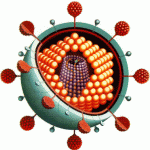Virology
|
30 july 2014 12:47:34 |
| First sero-prevalence of dengue fever specific immunoglobulin G antibodies in Western and North-Western provinces of Zambia: a population based cross sectional study (Virology Journal) |
|
Tweet Background:
Dengue fever is a tropical infectious disease caused by dengue virus (DENV), a single positive-stranded RNA Flavivirus. There is no published evidence of dengue in Zambia. The objective of the study was to determine the sero-prevalence and correlates for dengue fever specific IgG antibodies in Western and North-Western provinces in Zambia.
Methods:
A randomized cluster design was used to sample participants for yellow fever risk assessment. In order to rule out cross reactivity with other flaviviruses including dengue, differential antibody tests were done by ELISA. Data was processed using Epi Data version 3.1 and transferred to SPSS version 16.0 for analysis. Bivariate and multivariate analyses were performed to determine the association of dengue fever with various factors. Unadjusted odds ratios (OR), adjusted odds ratios (AOR) and their 95% confidence intervals (CI) are reported.
Results:
A total of 3,624 persons were sampled for dengue virus infection of whom 53.3% were female and 23.9% were in the 5-14 years age group. Most persons in the survey attained at least primary education (47.6%). No significant association was observed between sex and dengue virus infection (p = 1.000). Overall, 4.1% of the participants tested positive for Dengue IgG. In multivariate analysis, the association of age with Dengue infection showed that those below 5 years of age were 63% (AOR = 0.37; 95% CI [0.16, 0.86]) less likely to be infected with Dengue virus compared to those aged 45 years or older. A significant association was observed between grass thatched roofing and Dengue infection (AOR = 2.28; 95% CI [1.15, 4.53]) Respondents who used Insecticide Treated Nets (ITN) were 21% (AOR = 1.21; 95% CI [1.01, 1.44]) more likely to be infected with dengue infection than those who did not use ITNs. Meanwhile, participants who visited Angola were 73% (AOR = 1.73; 95% CI [1.27, 2.35]) more likely to be infected with Dengue virus than those who did not visit Angola.
Conclusion:
This study provides the first evidence of dengue infection circulation in both North-Western and Western provinces of Zambia. It is important that surveillance activities for Dengue and diagnostic systems are expanded and strengthened, nationwide in order to capture information related to dengue virus and other flaviviruses. |
| 61 viewsCategory: Virology |
 HCV RNA viral load is independent from CD4 cell count and plasma HIV RNA viral load in immunocompetent HIV-HCV co-infected patients: a 3-years follow-up study (AIDS Research and Therapy) HCV RNA viral load is independent from CD4 cell count and plasma HIV RNA viral load in immunocompetent HIV-HCV co-infected patients: a 3-years follow-up study (AIDS Research and Therapy)Compare mDCs and pDCs between two distinct patients groups in acute HIV-1 infection (AIDS Research and Therapy) 
|
| blog comments powered by Disqus |
MyJournals.org
The latest issues of all your favorite science journals on one page
The latest issues of all your favorite science journals on one page



